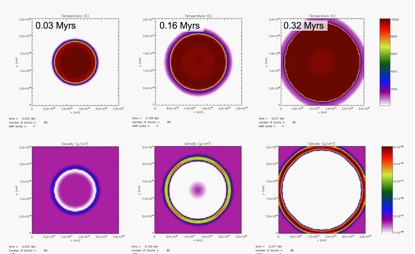2009 Annual Science Report
 Arizona State University
Reporting | JUL 2008 – AUG 2009
Arizona State University
Reporting | JUL 2008 – AUG 2009
Astrophysical Controls on the Elements of Life, Task 5: Model the Variability of Elemental Ratios Within Clusters
Project Summary
This task involves a comprehensive study of the chemical evolution of star forming regions arising from stellar processes, and its astrobiological implications. Our approach starts from the point of star formation and models the subsequent production, dissemination, and accretion of 92 chemical elements, with a special focus on bioessential elements and short-lived radionucides. Our goal is to capture the full evolution of over which molecular clouds – the primary units of star-forming gas – are converted into open clusters – the primary units of formed stars. We will then be able to determine the probability distribution of all elements that are important in the formation of terrestrial planets and life.
Project Progress
In the 7 months since this grant was awarded our main achievement was to implement the most difficult of the key physics packages that are necessary to model self-enrichment. Of the four feedback processes we are considering (protostellar jets, winds from massive stars, supernovae, and HII ionzation fronts) only ionization fronts involve nonlocal calculations that require ray-tracing in a massively parallel code environment. Furthermore, at early times after massive stars turn on, these fronts will travel at speeds that vastly exceed the sound speed in molecular clouds, requiring very small times steps that would catastrophically slow down our simulations. This is true even though it is only during the much longer and more slowly evolving D-type phase that HII fronts will have an important impact on molecular clouds structure, and hence on self-enrichment.
To overcome the problem of parallelization, we have completely reworked the “hybrid characteristic method” developed in Rijkhorst et al. (2008), which implements ray-tracing by combining “short characteristics” that are calculated on each processor separately, with “long characteristics” that communicate courser-grain information between processors. To overcome the problem of time-steps we have also developed and implemented an “instantaneous Strömgren method,” which balances ionizing photons with the total recombination rate along each line of sight, rather than carrying out a standard optical depth calculation. The result is a model in which the unimportant but computationally expensive R-type phase is circumvented completely, and the HII region expands as a D-type front at the hydrodynamic timescale. The results of one such calculation are shown in Figure 1, and we are now carefully comparing our method against other approaches and analytic solutions (eg, Iliev et al 2009) in a stand-alone publication (Hinkel et al 2009) to be submitted by the end of the calendar year.
Hinkel, N., Scannapieco, E., & Timmes, F. X. 2009, in preperation
Iliev, I,T., et al. 2009, MNRAS, in press (arXiv: 0905.2920)
Rijkhorst, E.-J., Plewa, T., Dubey, A., & Mellema, G., 2006, A&A, 452, 907

Figure 1. Cluster Evolution. Evolution of D-type ionization front in a uniform medium. At all times, and along every along each line of sight, the ionizing flux is taken to be the integrated recombination rate. This approach allows us to include the impact of HII fronts on developing clusters while still maintaining the Courant time step throughout the entire simulation.
-
PROJECT INVESTIGATORS:
-
PROJECT MEMBERS:
Francis Timmes
Co-Investigator
Natalie Hinkel
Graduate Student
-
RELATED OBJECTIVES:
Objective 1.1
Formation and evolution of habitable planets.
Objective 3.1
Sources of prebiotic materials and catalysts
